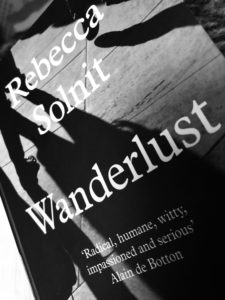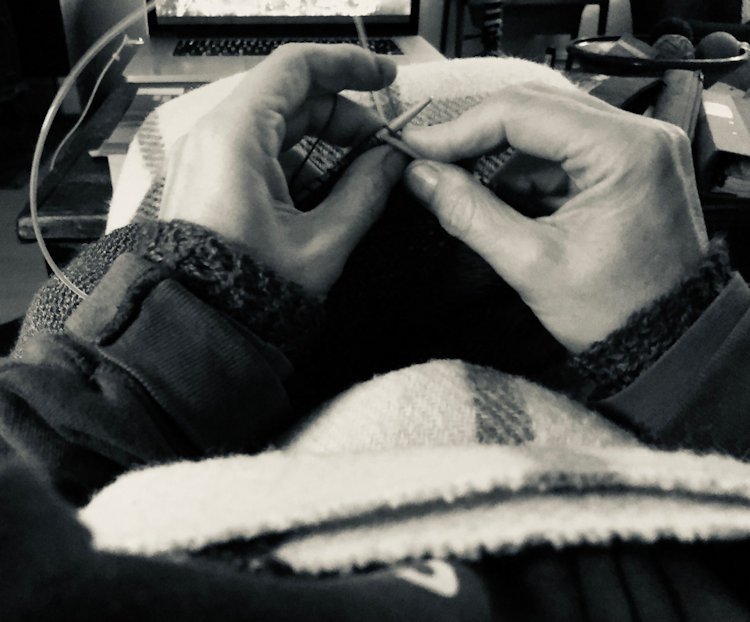 Wanderlust. Rebecca Solnit. Subtitled A History of Walking.
Wanderlust. Rebecca Solnit. Subtitled A History of Walking.
“[…] each walk moves through space like a thread through fabric, sewing it together into a continuous experience – so unlike the way air travel chops up time and space and even cars and trains do. This continuity is one of the things I think we lost in the industrial age – but we can choose to reclaim it, again and again, and some do. The fields and streets are waiting.”
The most beautiful of languages she has, Rebecca Solnit. There are passages in this book where I am enraptured, of the sheer beauty of the words strung together with intelligence and tender loving care, all at once. The first two pages of chapter three Rising and Falling: The Theorists of Bipedalism is one of those places. I marked it in my copy of the book, with the words What a magnificently beautiful passage!
“[..] the sense of place that can only be gained on foot. Many people nowadays live in a series of interiors – home, car, gym, office, shops – disconnected from each other. On foot everything stays connected, for while walking one occupies the spaces between those interiors in the same way one occupies those interiors. One lives in the whole world rather than in interiors built up against it.”
Rebecca Solnit manages to write an expose on walking that takes it far wider than my imagination could have conceived. Making me realize just how important walking is, how it has roots in our hominid-background, and how it is, perhaps, on the verge of extinction…
“When you give yourself to places, they give you yourself back; the more one comes to know them, the more one seeds them with the invisible crop of memories and associations that will be waiting for you when you come back, while new places offer up new thoughts, new possibilities. Exploring the world is one of the best ways of exploring the mind, and walking travels both terrains.”
The passages I bring forth here are all linked together; all relate to the sense of place and space of walking that Solnit circles back to, over and over again in Wanderlust. I could as easily have chosen the topic of revolutions or perhaps of citizenship, and how walking has played an integral part in shaping the history of humankind. Or perhaps the apparent gendered bias making public spaces available for walking by men, and not women, for millennia. But I didn’t. As I write these reflections, I flick though the pages of the books I’m to write about, and as my eye falls on my pencil-scribbles in the margins, what tugs at me shapes my writing. And thus, this is what wants to be reflected upon.
“But there are three prerequisites to going out into the world to walk for pleasure. One must have free time, a place to go, and a body unhindered by illness or social restraints.”
I go for walks. By my very lonesome. Revelling in the different vistas my neighboring recreational area of Bulltofta grant me as seasons pass.
I take walk n talks as often as I can. Whenever someone asks me to join them for a cup of tea (usually they suggest coffee which I don’t even drink…), I almost always suggest a walk n talk instead.
And. I do CoachWalks, talking my clients walking with me, often along the paths of Bulltofta where I spend so much of my time. I usually look up, throw my arms to the side and exult Welcome to my office! When in physical motion, it’s hard – not to say impossible – for the mind to be immobile. So walking is one of my secret tools in my coaching tool box.
“Walking has been one of the constellations in the starry sky of human culture, a constellation whose three stars are the body, the imagination, and the wide-open world, and though all three exist independently, it is the lines drawn between them – drawn by the act of walking for cultural purposes – that makes them a constellation. Constellations are not natural phenomena but cultural impositions; the lines drawn between stars are like paths worn by the imagination of those who have gone before. This constellation called walking has a history., the history trod out by all those poets and philosophers and insurrectionairies, by jaywalkers, streetwalkers, pilgrims, tourists, hikers, mountaineers, but whether it has a future depends on whether those connecting paths are travelled still.”
Wanderlust. And important book.
Pick it up. Read it. And never look upon Walking quite the same way ever again.
The book I am blogging about is part of the book-reading challenge I’ve set for myself during 2018, to read and blog about 26 Swedish and 26 English books, one book every week, books that I already own.
